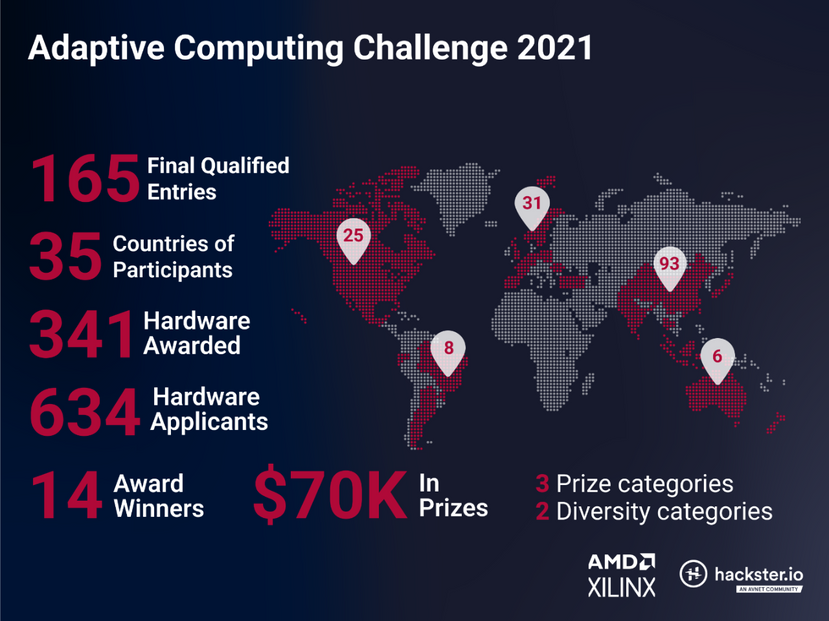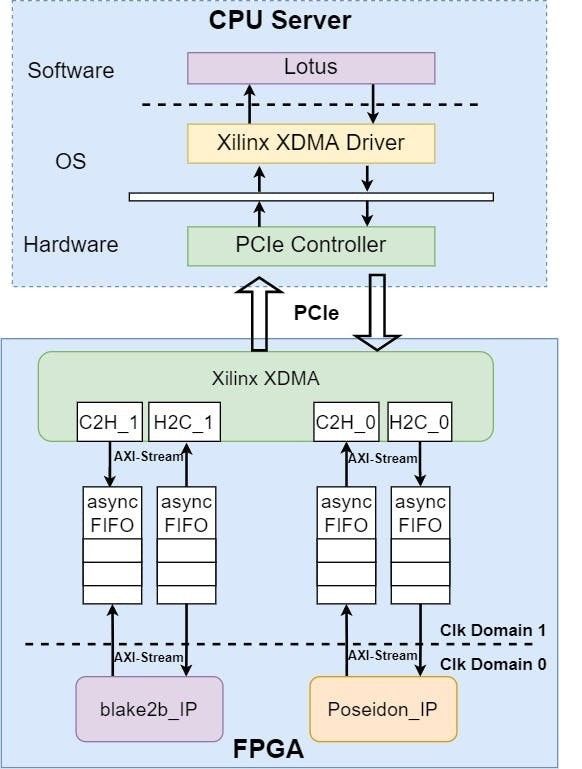
Now in its second year, the Adaptive Computing Challenge 2021 contest challenges developers to create innovative applications combining the power of AMD-Xilinx adaptive computing platforms with our Vivado® ML, Vitis™ unified software platform, and Vitis AI development environments to solve real-world problems.
This year’s challenge consisted of three main categories, each with a top prize of $10,000 USD:
We also introduced two new categories: the “Xilinx University Program”, where university students can submit their projects as well as the Women in Technology” category. Both categories include a top cash prize of $2,500 USD.
We’re again collaborating with Hackster.io to run the contest. This year’s challenge saw over 2,000 registrations, producing 634 hardware applications and resulting in 165 qualified entries from developers spanning 35 countries. A total of 14 award winners were selected across the five categories, with a total prize pool of $70,000 USD. With more than 3X the number of qualified entries compared to last year, we’re thrilled by the significant growth of the challenge and want to thank everyone that participated.

And the winners are….
Category: Edge Computing with Xilinx Kria™ KV260 Vision AI Starter Kit
Winning Project: KARP – Kria Autonomous Robotics Platform

Meet Karp (Kria Autonomous Robotics Platform) built using the Kria KV260 Vision AI Starter Kit. The KV260 kit provides an affordable and easy-to-use development platform for designing vision applications, right out of the box. The development platform for Kria K26 SOMs, the KV260 is built for advanced vision application development without requiring complex hardware design knowledge.
The project makes use of different advanced technologies like AMD-Xilinx FPGAs, Vitis AI 2.0, ROS 2, Odrive motor controller, Velodyne lidar and more. KARP is easily customizable depending on the application users want to give to this low-cost robotic platform.
Check out the full details on the hardware and software used for building KARP here: https://www.hackster.io/jlamperez10/karp-5e19e9
Category: Data Center AI with Xilinx VCK5000 Development Card
Winning Project: Instant Medical Image Analysis Aid for 8 Clinic Exam Rooms
In this category, judges looked for the best use of our VCK5000 Versal Development Cards, combined with Vitis AI, to accelerate AI inference. The VCK5000 development card is built for designs requiring high throughput AI inference and signal processing compute performance.
In order to detect polyps precisely and lighten the burden for doctors, the team of developers built a real-time polyp detection system using the VCK5000 development card, which was able to process a batch of up to eight polyp segmentation tasks simultaneously in real-time without sacrificing inference speed for multiple tasks.
The images from each individual instrument can be sent to the server over networks. After that, the server can utilize VCK5000 with the built-in DPU to detect polyps. The segmentation results will finally be sent back to the original instruments.
With these results, doctors can explain their disease more clearly to patients. Moreover, surgical videos with highlighted polyps are valuable for academic discussion. The team hopes this idea can contribute to the medical community and help doctors save more lives.

Learn more about this project here: https://www.hackster.io/nycity/instant-medical-image-analysis-aid-for-8-clinic-exam-rooms-847669
Category: Big Data Analytics with Xilinx Varium™ C1100 Accelerator Card
Winning Project: TRIDENT: A Hardware Implemented Poseidon Hasher
This category exclusively focused on accelerating blockchain applications, including Proof of Work algorithms that require high memory bandwidth and transaction validation for permission blockchains such as Hyperledger Fabric. We challenged developers to build solutions on the Varium C1100 Blockchain Accelerator Card that make blockchain protocols and infrastructure more efficient and scalable.
The TRIDENT system provides a complete solution for accelerating Poseidon Hasher in FPGA, including hardware design and software API. The Poseidon hasher is widely used in blockchain projects for their zero-knowledge cryptographic proof, known as ZK-SNARK. This project aims to accelerate ZK-SNARK by implementing the Poseidon hasher on hardware.
The team implemented TRIDENT as a block design in the Vivado Design Suite. The Poseidon hasher is written in Spinal-HDL, then converted to Verilog, and uses custom IP in Vivado. The Varium C1100 blockchain accelerator card is used in the XDMA PCI-E IP in AXI4-Stream mode to write/read data to/from the FPGA. Filecoin’s “Neptune” Rust API is modified to switch Poseidon hashing from GPU to FPGA. TRIDENT has achieved more than twice the throughput performance of a CPU implementation and much higher performance-power ratio than GPUs.

Check out the full project details here: https://www.hackster.io/datenlord/trident-a-hardware-implemented-poseidon-hasher-79025f
Special Award Categories
Xilinx University Program:
The winning project: All-in-one Self-adaptive Computing Platform for Smart City
For this project, students designed a flexible video processing framework on a Kria KV260 SOM, which can be used in a smart camera application for intelligent transportation systems in a smart city.
The framework is not only capable of automatically detecting application scenarios (e.g. car or pedestrian) using a semantic segmentation and road line detection network, it is also able to automatically select the best of the DNN models for the application scenarios. Thanks to the dynamic reconfiguration and run-time management APIs, the system is able to dynamically switch the DNN inference model at run-time without stopping the video pipeline. This finally allows our smart camera system to be truly adaptive and achieve the best performance in a smarter way.
Full project details are available here: https://www.hackster.io/yufan-lu/all-in-one-self-adaptive-computing-platform-for-smart-city-933ff2
Women in Technology:
The winning project: J-Eye: Intramuscular Site Detection for Autonomous Injection
The team developed J-Eye, a low-cost 2D vision-AI-assisted intramuscular injection site detection application on the Kria KV260 board using the Vitis tools suite. The ultimate goal is to empower the next generation of autonomous vaccine injection by providing a lower cost alternative solution, which can be implemented on the FPGA board with easy setup.

Learn more here: https://www.hackster.io/j-eye/j-eye-intramuscular-site-detection-for-autonomous-injection-a1c333
A BIG thank you to everyone that participated in making the 2021 Adaptive Computing Challenge. Stay tuned for the announcement of next year’s challenge.